The Biggest Cultural Event the Year You Were Born
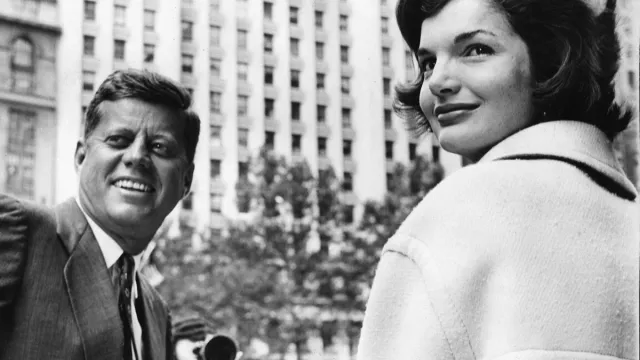
Every year, there is at least one event so massive and widespread that you can’t possibly avoid hearing about it—even if you’re actually living under a rock. They’re the events that dominate news headlines for days, and even weeks, at a time—the kind of things that cause people to remember exactly where they were and what they were doing when they first heard about them.
Even in the days before news spread in seconds via the internet, major cultural events were uniting the nation and shaping history. To help jog your memory, we’ve gone back through the years to round up the moments that defined each year since 1950. And for more nostalgia, check out the 100 Slang Terms From the 20th Century No One Uses Anymore.
1950: President Truman signs the Organic Act of Guam.

When President Harry Truman signed The Organic Act of Guam into law in 1950, it secured Guam’s place as an unincorporated territory of America, thereby ending a 50-year appeal by the island for a governing body.
Though the 1950 version of the act gave American citizenship to all residents of Guam and their children, it also stated that these citizens would not be able to vote in general United States elections. A 1968 amendment to the act allowed for the governor of Guam to be chosen via a popular election, whereas the official had previously been chosen by the president. And even though they are not allowed to vote for president, they can vote for party delegates in presidential primaries, as NBC News explains. And to find out which place in the U.S. is not exciting, This Is the Most Boring State in the U.S.
1951: The first television show in color airs.

When you flip through cable channels today, you’re met with an array of vivid colors. But television wasn’t always that way; rather, the first TV show to air in color didn’t hit airwaves until 1951.
Appropriately called Premiere, the striking show was broadcast by CBS in just four cities: Boston, Philadelphia, Baltimore, and Washington, D.C. And though Premiere‘s premiere was a momentous point in history, color TVs didn’t become widespread until the ’60s and ’70s. And if you want to learn more TV and film trivia, then check out 50 Iconic Movie Roles That Almost Went to Someone Else.
1952: Queen Elizabeth II takes the throne.

Queen Elizabeth II is universally beloved today. However, the Queen didn’t truly take center stage until 1952, when she took the throne following the death of King George VI. As the elder of the king’s two daughters, Elizabeth was next in line for the crown. She was officially coronated in June 1953.
1953: DNA’s chemical structure is discovered.

Though DNA was discovered in 1869, its significance as it pertains to our genetic make-ups wasn’t discovered until 1943. Then, it was another 10 years before two Cambridge University scientists, James D. Watson and Francis H.C. Crick, determined the double-helix structure of the molecule, a discovery that earned them the Nobel Prize in 1962. Their revelation not only improved our understanding of DNA itself, but ultimately also paved the way for medical and scientific research that has saved millions of lives since.
1954: The Brown v. Board of Education ruling takes place.

The landmark Supreme Court case that is Brown v. Board of Education of Topeka took place in 1954, when the Supreme Court judges unanimously ruled that racial segregation in public schools was unconstitutional. It was a blow to the previous 1896 ruling in Plessy v. Ferguson that set the “separate, but equal” precedent. More than 60 years later, this case is considered one of the most instrumental in the fight for civil rights.
1955: The polio vaccine is cleared.

The paralysis-inducing polio disease plagued people all throughout the 19th and early 20th century. Then, in 1953, Dr. Jonas Salk announced that he had successfully developed a vaccine that could eliminate the threat almost entirely. In April 1955, it was announced that the vaccine was effective and safe, and an oral version was developed by Albert Sabin in 1961. And for more interesting information delivered straight to your inbox, sign up for our daily newsletter.
1956: Elvis Presley releases his debut album.

In 1956, Elvis Presley released his self-titled debut album, featuring now-classic tunes like “Blue Suede Shoes” and “Tutti Frutti.” The album topped the Billboard charts for 20 weeks following its release.
1957: The first artificial satellite is launched into space.

Though America has made a lot of advancements in space travel over the years, the first artificial satellite launched into space—called Sputnik I—was actually sent there by the Soviet Union. Though this satellite was only the size of a beach ball, its significance was massive; it provided valuable information about the Earth’s atmosphere to scientists and paved the way for the start of the space race.
1958: NASA is established.

In response to the Soviet Union’s incredible space advancements, Congress passed legislation establishing the National Aeronautics and Space Administration—better known as NASA—in July 1958. The agency was established following the launch of the United States’s first successful satellite, Explorer I, just months prior in January.
1959: Alaska and Hawaii join the United States.

Rounding out the 50 states, both Alaska and Hawaii were admitted into the U.S. as states in 1959. However, these territories belonged to America long before they became an official part of the country: Alaska was purchased as a United States territory from Russia in 1867, while Hawaii was annexed in 1898.
1960: The first-ever televised presidential debate airs.

In 1960, the first-ever nationally televised presidential debate took place in a Chicago studio. The debate, which focused on domestic policies, featured democratic hopeful John F. Kennedy and republican vice president Richard Nixon. Many people attribute Kennedy’s eventual win to this—and other—televised debates, as Americans were charmed by his charisma.
1961: The first men arrive in space.

The U.S.-Soviet space race was still at an all-time high in 1961. And the Soviet Union pulled ahead once again during this time when they successfully sent the first man into space just a month before America’s launch was scheduled. The man the Soviets sent was Yuri Gagarin, a 27-year-old test pilot, and his time in space lasted approximately 108 minutes.
1962: The first James Bond movie is released.
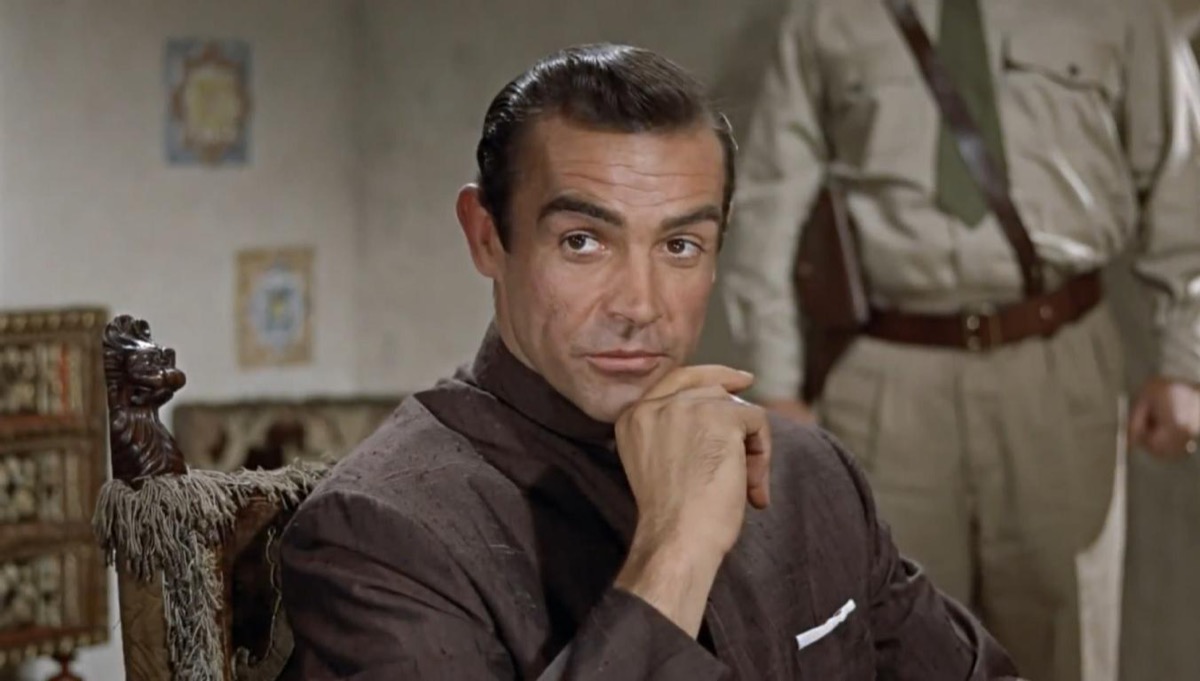
Sean Connery first brought Agent 007 to the big screen in 1962, back when the first film of the James Bond saga—Dr. No—was released. First created by novelist Ian Fleming in the 1950s, James Bond has seen quite a bit of screen time since then; to date, there have been 26 James Bond movies, featuring everyone from Daniel Craig to Pierce Brosnan in the titular role.
1963: President John F. Kennedy is assassinated.
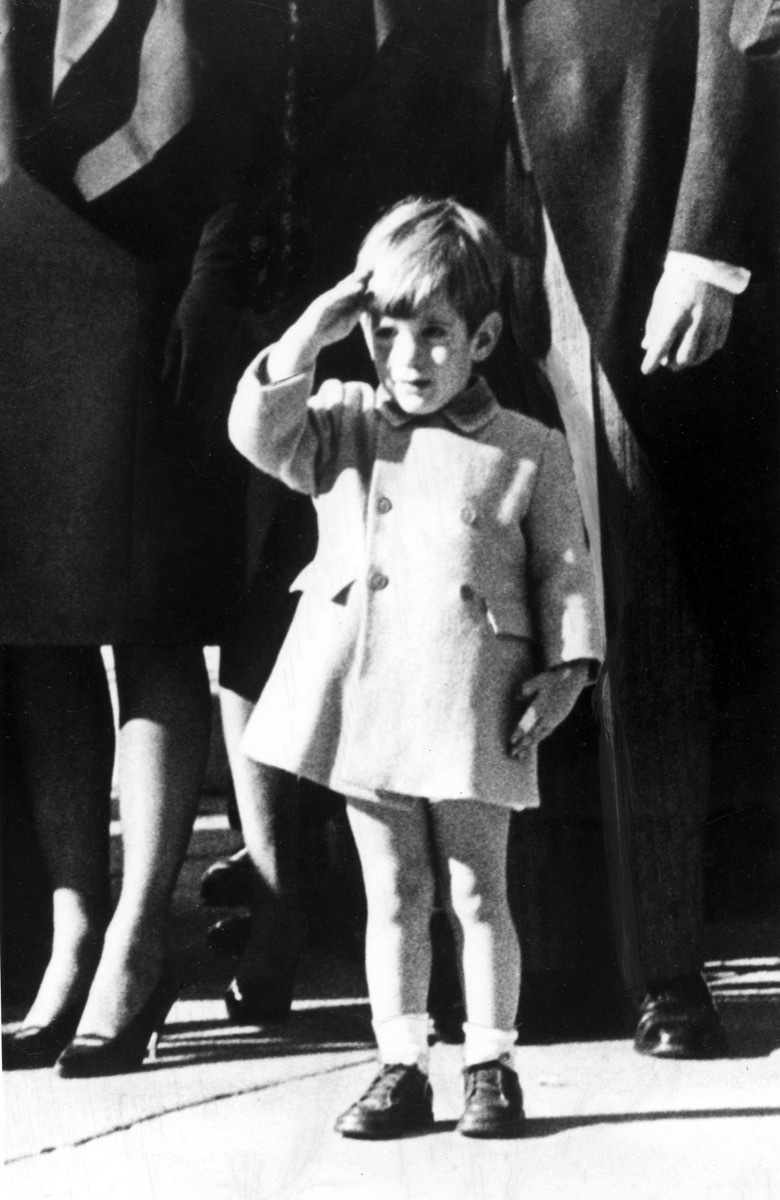
In a moment that will never be forgotten, history was forever altered in 1963 when President John F. Kennedy was assassinated while in Dallas for a campaign event. As crowds lined the streets to get a glimpse of the president riding by in his motorcade, a shot was fired at Kennedy’s top-down limousine, killing him in cold blood at just 46 years old. And this image of his son, John F. Kennedy, Jr., at his funeral on November 25, 1963, is forever etched in our brains.
1964: Congress passes the Civil Rights Act.

Possibly no event in the last 50 years has been as impactful on American society as the Civil Rights Act of 1964. Signed into law by President Lyndon B. Johnson, the act ended public segregation and banned employment discrimination on the basis of race, color, religion, sex, or national origin.
1965: The first spacewalks occur.
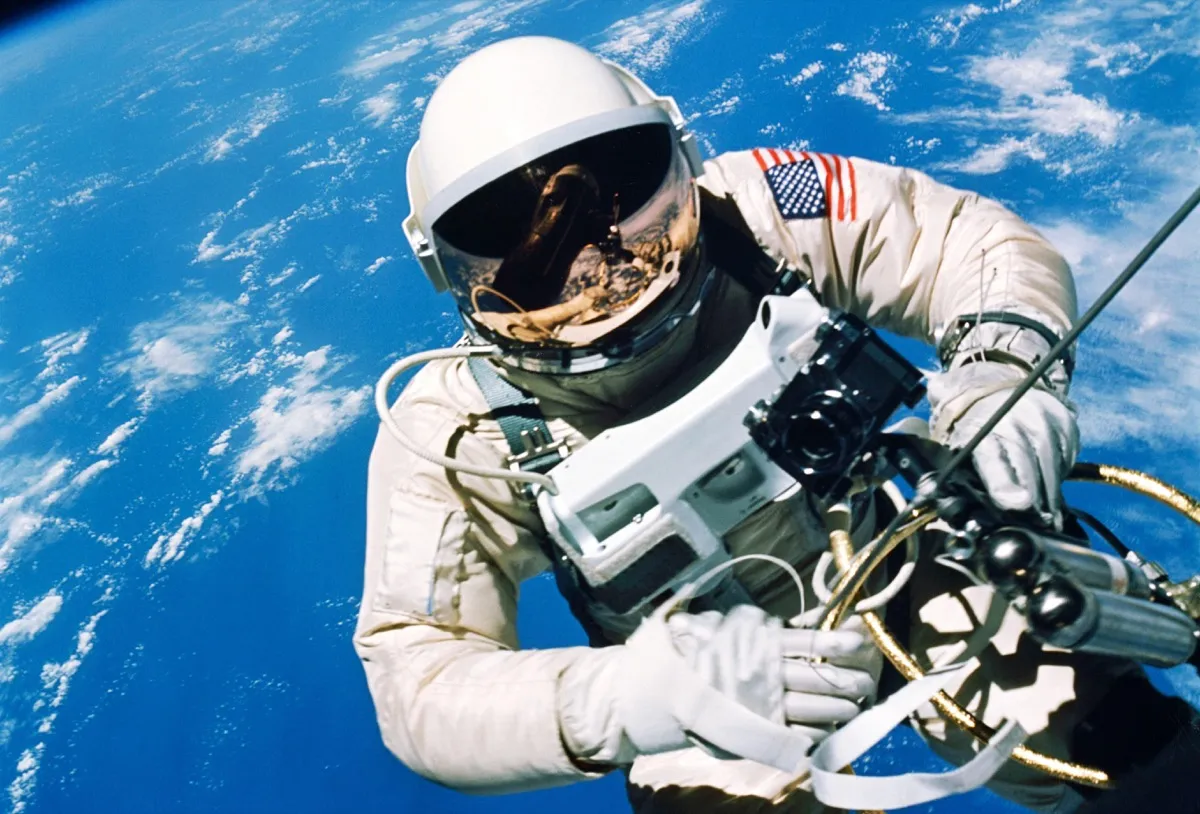
During his mission on Gemini 4 in June 1965, Ed White became the first American to take a spacewalk—a 23-minute feat that was historic for America. He was not the first human to walk in space, however, as months prior Soviet astronaut Alexei Leonov successfully took the first spacewalk for nearly 10 minutes.
1966: The Supreme Court rules on the Miranda rights.

During the Miranda v. Arizona case of 1966, the Supreme Court established the Miranda rights principle, stating that all criminal suspects must be told their rights before interrogation. The case followed a confession by alleged rapist Ernesto Miranda, who recanted his confession after learning that he wasn’t required to speak in his interrogation, something he wasn’t made aware of by law enforcement.
1967: The “Summer of Love” takes place.

The “Summer of Love” refers to the psychedelic, hippie-centric summer of 1967. The epicenter of the movement was in San Francisco, where thousands of young people gathered in the Haight-Ashbury district, enjoying peace, love, and the pursuit of happiness.
1968: Martin Luther King Jr. is assassinated.

Only five years after the assassination of JFK, another notable figure was killed: civil rights activist Martin Luther King, Jr. While in Memphis, Tennessee, supporting a sanitation worker’s strike, the 39-year-old was shot and killed as he stood on the balcony of the Lorraine Motel. The news of his assassination sent shockwaves throughout America, sparking protests and riots all over the nation.
1969: Neil Armstrong becomes the first man on the moon.

After years of coming in second place, the United States finally beat the Soviets in 1969 when they sent Apollo 11 to the moon and became the first country to successfully land humans there. Neil Armstrong, the first astronaut to actually step out onto the moon, famously stated that the feat was “one small step for a man, one giant leap for mankind.”
1970: Music legends Jimi Hendrix and Janis Joplin pass away.

The world was turned upside down when legends Jimi Hendrix and Janis Joplin both passed away in 1970 at just 27 years old. Their deaths were the starting point for what eventually became known as the “27 Club,” a group of notable and talented musicians who all died at the age of 27, including Kurt Cobain, Jim Morrison, and Amy Winehouse.
1971: Walt Disney World opens to the public.

Following the success of Disneyland in California, Walt Disney envisioned an even larger theme park—and his dreams came true in 1971 when the Walt Disney World Resort opened to the public in Orlando, Florida. Unfortunately, though, Disney himself never actually saw his dreams become a reality, seeing as he died in 1966.
1972: The Watergate Scandal takes Nixon out.

Perhaps one of the biggest controversies in American history was the Watergate scandal of 1972. People connected to the Nixon re-election campaign were found breaking in to the Democratic National Committee headquarters in Washington, D.C. The subsequent investigations and articles by the Washington Post revealed a laundry list of abuses of power by the Nixon administration, forcing the president to resign in 1974 as he faced near-certain impeachment.
1973: The Supreme Court rules on Roe v. Wade.

The 1973 landmark case of Roe v. Wade established a woman’s legal right to an abortion. In a 7-2 vote, the Supreme Court ruled that a woman’s right to an abortion was guaranteed by the Fourteenth Amendment of the United States Constitution, setting the precedent for women’s right to choose.
1974: Stephen King publishes his debut novel.

When people think of horror fiction, there’s one name that comes to mind more than any other: Stephen King. However, it wasn’t until 1974 that the “King of Horror” released his debut novel, Carrie. The book not only launched King’s explosive career, but it also spawned several movie adaptations and even a Broadway musical.
1975: The Vietnam War ends.

The Vietnam War was a controversial conflict between communist North Vietnam and South Vietnam, which found an ally in the United States. Two years after the United States began to withdraw from Vietnam, the long and costly war finally came to an end when communist forces seized control of South Vietnam in 1975, uniting the country as the single Socialist Republic of Vietnam.
1976: Patty Hearst is sentenced.

In 1974, Patty Hearst, the 19-year-old daughter of newspaper publisher Randolph Hearst, was kidnapped from her apartment supposedly by the Symbionese Liberation Army (SLA). However, after she came out and claimed she joined the SLA of her own free will, Hearst was named as a suspect in several armed robberies. Despite her later claims that she had been brainwashed by the SLA when she was captured and arrested, she was convicted and sentenced to seven years in prison in 1976.
1977: The first Star Wars film hits theaters.

Star Wars is quite possibly the most iconic—not to mention one of the longest-running—movie phenomenons in the world. However, back in 1977, the first film in the franchise was just hitting the big screen, eventually developing the massive following it has today.
1978: The Jonestown Massacre occurs.

In 1978, more than 900 members of an American cult called the “Peoples Temple” died during a harrowing mass suicide-murder in South America under the guidance of their cult leader, Jim Jones. The massacre at Jonestown, as it became known, is one of the most horrific (and mysterious) tragedies in American history, and even today people question why so many individuals willingly followed such a cruel leader around for years.
1979: Michael Jackson releases his breakthrough Off the Wall album.

After Michael Jackson found his fame with the rest of his siblings in the Jackson 5, in 1979 he started his solo career with the release of his breakthrough album, Off the Wall. Hailed as a major turning point in the King of Pop’s career, the album included iconic hits like “Don’t Stop ‘Til You Get Enough” and “Rock with You.”
1980: CNN begins broadcasting.

In 1980, the 24-hour news cycle was born with the creation of CNN. The first program of its kind, CNN offered news all day, every day while other programs were only available at fixed times. From its headquarters in Atlanta, Georgia, the network debuted with the story of the attempted assassination of civil rights leader Vernon Jordan.
1981: Sandra Day O’Connor is appointed to the Supreme Court.

One of the most critical and influential moments in women’s history was Sandra Day O’Connor’s appointment to the Supreme Court in 1981. When President Ronald Reagan appointed O’Connor, she became the first female Supreme Court Justice in history, following in the footsteps of more than 100 men prior.
1982: AT&T is ordered to break up.

While its success today is massive, AT&T’s history is a tumultuous one. When the government thought the company was getting too big for its own good, it ordered AT&T to break up in 1982 into eight separate companies. Though AT&T is now back to being a single entity, this government-regulated ruling was a huge turning point for the disbandment of monopolies.
1983: Michael Jackson introduces the moonwalk.

The moonwalk is one of the most well-known dance moves in history, created by the King of Pop. Jackson introduced the moonwalk in 1983 during a performance of “Billie Jean” at the Motown 25: Yesterday, Today, Forever concert. An adaptation of the former backslide dance, Jackson’s moonwalk immediately mesmerized fans and solidified the artist’s place as one of the most incredible dancers of all time.
1984: The dystopian Apple Macintosh ad airs.

In 1984, Apple Macintosh released one of the most iconic and influential commercials of all time. The dystopian ad, which aired during the Super Bowl, was appropriately inspired by George Orwell‘s 1984 novel and introduced the world to both Macintosh computers and the phenomenon that is Super Bowl ads.
1985: Coca-Cola releases “New Coke.”

It’s an understatement to say that when the Coca-Cola Company unveiled their “New Coke,” people were upset. The soda launched in 1985 as a reformulation of Coca-Cola—the first change in 99 years!—and it caused a public uproar, forcing the company to switch back to the original formula just months later. However, New Coke came back in 2019 as part of a promotional campaign for the beloved ’80s-set sci-fi show, Stranger Things.
1986: “Hands Across America” takes place.
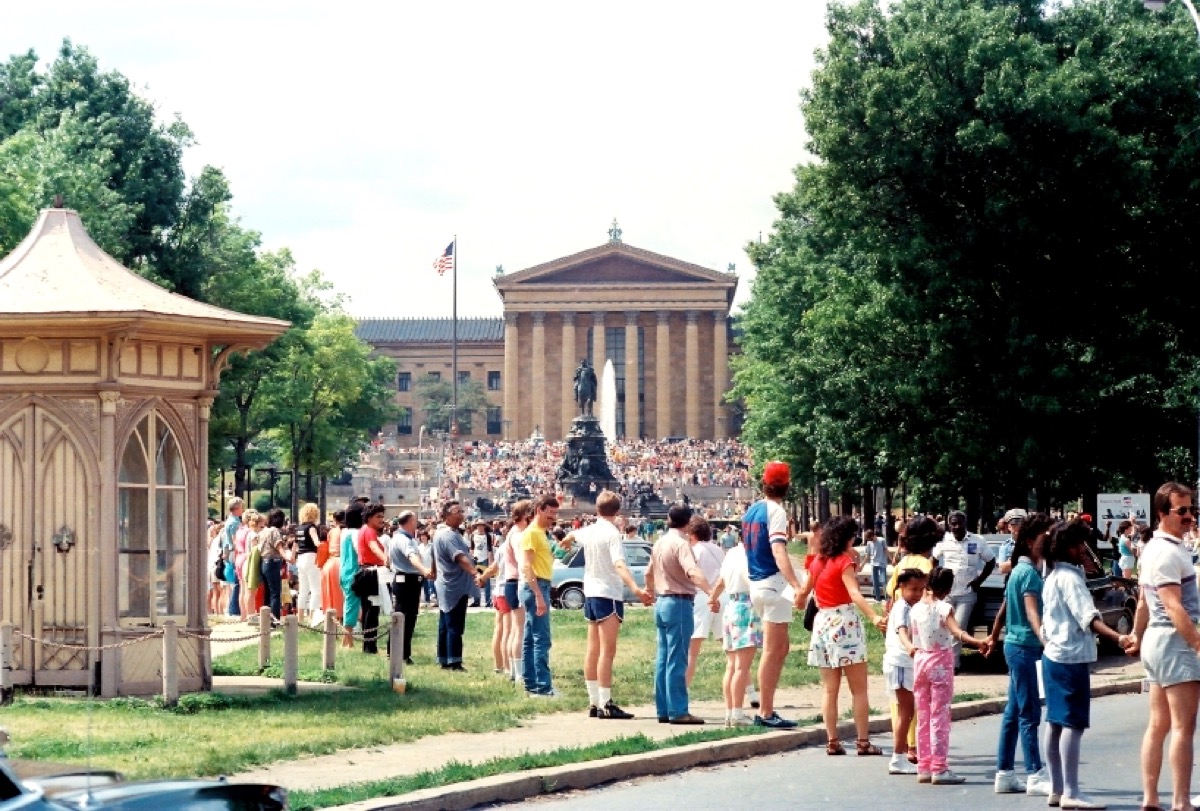
Ken Kragen, president of the charity USA for Africa, famously campaigned to raise money for famine-stricken Africa. But in 1986, he turned his sights back home with the idea for this iconic event to help raise money for hungry and homeless Americans.
With nearly six million people involved, the coast-to-coast human chain was such a huge event that it took nearly nine months to plan. On the day of “Hands Across America,” May 25, 1986, people held hands for 15 minutes as they sang iconic tunes like “We Are the World” and “America the Beautiful”—a moment remembered by those who participated and those who watched on.
1987: Baby Jessica is rescued.

Jessica McClure became a well-known figure at just 18 month old when she fell down a well in the backyard of her aunt’s home in Texas. Over the course of 58 hours, viewers from all over the nation watched as crews fought to rescue “Baby Jessica,” eventually succeeding. The moment united Americans in their concern for Jessica’s safety; at one point, even President Reagan joined in and observed the efforts.
1988: The Phantom of the Opera opens on Broadway.

Andrew Lloyd Webber’s The Phantom of the Opera is easily one of Broadway’s most iconic musicals of all time. It’s also the longest-running show on Broadway, seeing as it hasn’t stopped running since it opened in 1988. The show was such a hit when it first opened that it grossed $26 million in its first year alone.
1989: The Berlin Wall falls.

The Berlin Wall was built in 1961 by East Germany in order to separate it from the “fascists” in West Germany—and it stood there until 1989, when East Germany announced plans to tear down the wall so that any German citizen, western or eastern, could pass through the border freely. The news was so revolutionary that crowds swarmed the wall the night it was announced, bringing hammers and picks with them to chip away at the concrete exterior.
1990: Nelson Mandela is released from prison.

Nelson Mandela, the leader of the South African apartheid and member of the African National Congress (ANC), was first arrested for treason in 1961, though he was quickly acquitted. The following year, however, he was arrested for attempting to illegally leave the country and subsequently sentenced to five years in prison.
During this sentence, Mandela was delivered yet another blow when he was put on trial for charges of sabotage in ’64 and sentenced to life in prison alongside other members of the ANC. However, in 1990, the new South African president F.W. de Klerk ordered the release of Mandela, and he was let out of prison on Feb. 11, 1990, after 27 years behind bars.
1991: People are introduced to the World Wide Web.

The World Wide Web was created in 1989 by British computer scientist Tim Berners-Lee, whom we also have to thank for things like HTML, URI, and HTTP.
Just because Berners-Lee created the World Wide Web in the late ’80s, though, doesn’t mean that the rest of the world got a taste of it then. Rather, the first web page wasn’t made available to the public until 1991—a moment that shaped virtually all modern technology.
1992: Minnesota’s Mall of America opens its doors.

When visiting Minnesota, most people head to the Mall of America—the largest shopping mall in the nation. In fact, it is such an American obsession that some people head to the state just to go to the mall.
This tourist attraction, however, wasn’t built until 1992. Once the former stadium space for the Minnesota Twins and Vikings, the landmark shopping center opened with nearly 300 stores at the time. Today, there are more than 500!
1993: Jurassic Park hits the big screen.

Steven Spielberg’s first installment in the Jurassic Park franchise was released in 1993. The blockbuster became an instant classic thanks to its use of computer-generated imagery mixed with live action—a move that both helped shape future big-name films and permanently cement Jurassic Park’s place in cinematic history. The film was so iconic that it was even added to the Library of Congress’s National Film Registry in 2018.
1994: Figure skater Tonya Harding is stripped of her title following the Nancy Kerrigan attack.

The infamous Tonya Harding–Nancy Kerrigan figure skating scandal is one that will go down in history. In 1994, Olympic hopeful Kerrigan was attacked and injured by a mysterious suspect. Six months after the attack, her rival, Harding, was stripped of her 1994 national championship by the U.S. Figure Skating Association and banned from the organization, as they claimed that Harding had prior knowledge and had possibly even helped to initiate the attack. The decision was one that shocked both the skating community and Americans at large, who watched intently as the scandal unfolded.
1995: O.J. Simpson is found not guilty.

Following the year-long media storm surrounding the O.J. Simpson trial, the jury finally made its decision regarding the former football star’s murder charges on October 3, 1995: not guilty. Despite evidence that Simpson had murdered his estranged wife, Nicole Brown Simpson, and waiter Ronald Goldman, the courts found the superstar athlete innocent. It was a verdict that shocked people all over the globe and inspired Simpson’s controversially named book about the events, If I Did It.
1996: Dolly the Sheep is cloned.

Scientific advancements were at an all-time high in 1996 with the birth of Dolly the Sheep, the first mammal to be successfully cloned from an adult cell. While many saw this as a huge advancement in medicine, others feared what it could lead to in the future: human cloning.
1997: Princess Diana is killed in a car crash.

The world lost an icon with the death of Princess Diana in 1997. The People’s Princess was killed at just 36 years old when she was involved in a car crash in Paris. The news was met with an outpouring of grief—not just from British citizens, but from people all over the world.
While the crash has been attributed to her driver’s speed and alcohol levels, many conspiracy theories have arisen around her untimely death.
1998: The Clinton-Lewinsky scandal comes to light.

The infamous affair between President Bill Clinton and his intern Monica Lewinsky first came to light in 1998. Their relationship began in 1995, and when news broke three years later, Clinton initially denied it with the infamous line, “I did not have sexual relations with that woman.”
Clinton did eventually admit to the affair, and afterwards the president was impeached by the House of Representatives for perjury and obstruction of justice. However, following a five-week trial, Clinton was acquitted by the Senate and finished out his second term.
1999: The Columbine High School massacre occurs.

One of the worst school shootings in American history occurred on April 20, 1999, at the Columbine High School in Littleton, Colorado. It was on this deadly day that two teens ended up killing 12 students and one teacher before ending their own lives in the school’s library, making it, at the time, the deadliest shooting at an American school. Columbine was only surpassed in 2012 by the Sandy Hook Elementary School shooting, where 28 individuals were killed.
2000: One of the closest presidential elections takes place.

The 2000 election that pitted Republican nominee George W. Bush against Democratic nominee Al Gore in 2000 was one of the closest presidential elections in United States history—so close, in fact, that some still don’t believe the results were accurate.
In the swing state of Florida at the turn of the century, there was a less than 0.5 percent difference, which resulted in an automatic recount. After weeks of fighting and court hearings, Bush was declared the winner of the popular vote by the Supreme Court in a decision many people still find to be controversial. And for more on America’s history, don’t miss these 25 Basic American History Questions Most Americans Get Wrong.